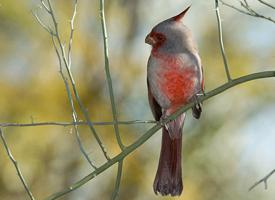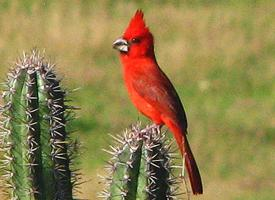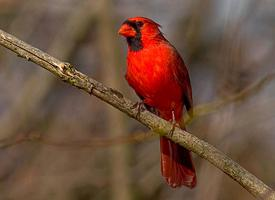
Állatleírás
The Pyrrhuloxia, scientifically known as Cardinalis sinuatus, is a striking and distinctive bird native to the arid regions of the American Southwest, including parts of the United States and Mexico. This bird is a member of the cardinal family, sharing many characteristics with its more widely recognized relative, the Northern Cardinal, but it is easily distinguishable by its unique coloration and morphology.Adult Pyrrhuloxias are medium-sized birds with a robust build and a prominent crest that adds to their regal appearance. One of the most notable features of the Pyrrhuloxia is its color palette. Unlike the vivid red of the Northern Cardinal, the Pyrrhuloxia boasts a more subdued gray body with hints of olive or brown. The males have striking red highlights that brighten their face, crest, wings, and tail, creating a stark contrast against their grayish body. Females, while generally paler and more uniform in color, also display subtle red accents, though to a lesser extent than males. Both sexes have a thick, strong bill that is uniquely shaped, almost parrot-like, adapted for cracking open seeds and slicing through the husks of desert plants.
The habitat of the Pyrrhuloxia is closely tied to the desert and arid landscapes of the Southwest, where they prefer areas with a mix of thorny brush and open spaces. These birds are well adapted to their environment, thriving in areas that offer them both food and shelter among the cacti, mesquite, and other desert vegetation. They are year-round residents of their range, showing a remarkable resilience to the extremes of desert life.
Pyrrhuloxias are primarily seed eaters, with their diet consisting of a wide variety of seeds and grains. During breeding season and when available, they also consume insects, which provide essential protein for the development of their young. Their strong bills are perfectly suited for their omnivorous diet, allowing them to exploit a range of food sources throughout the year.
The song of the Pyrrhuloxia is another characteristic that sets it apart. It is a sweet, warbling melody that is less forceful than that of the Northern Cardinal but equally enchanting. During the breeding season, males can be seen perched prominently on a high vantage point, singing to establish their territory and attract a mate.
Breeding pairs of Pyrrhuloxias are monogamous, with both parents participating in nest building, incubation, and feeding of the young. Nests are typically built in dense shrubbery or thorny trees, providing protection from predators. The female lays a clutch of 3 to 4 eggs, which are incubated for about two weeks before hatching. The young are altricial, meaning they are born blind and featherless, completely dependent on their parents for food and protection.
In summary, the Pyrrhuloxia is a fascinating and resilient bird, perfectly adapted to the challenging conditions of its desert habitat. With its distinctive appearance, intriguing behaviors, and melodious song, it is a symbol of the beauty and diversity of the American Southwest's avian life.
Hasonló állatok
Új állatfotók
Top 10 állat
- Dolphin gull (Leucophaeus scoresbii)
- Japanese macaque (Macaca fuscata)
- Stone loach (Barbatula barbatula)
- Russian tortoise (Testudo horsfieldii)
- Galápagos tortoise (Geochelone nigra complex)
- Greek tortoise (Testudo graeca)
- Diana monkey (Cercopithecus diana)
- Common flying dragon (Draco volans)
- Moustached guenon (Cercopithecus cephus)
- Galápagos penguin (Spheniscus mendiculus)

